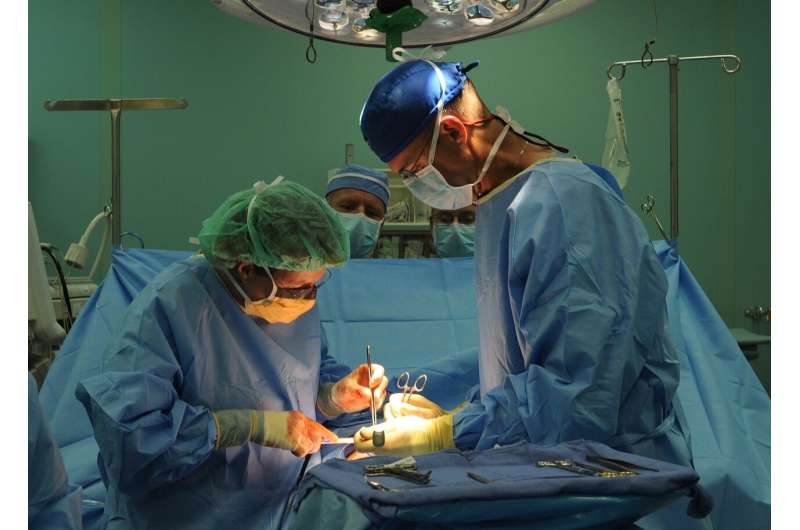Lung cancer outcomes found to significantly improve with immunotherapy-based treatment given before and after surgery

A regimen of pre-surgical immunotherapy and chemotherapy followed by post-surgical immunotherapy significantly improved event-free survival (EFS) and pathologic complete response (pCR) rates compared to chemotherapy alone for patients with operable non-small cell lung cancer (NSCLC), according to results of a Phase III trial reported by researchers at The University of Texas MD Anderson Cancer Center.
The findings, published in the New England Journal of Medicine, were first presented at the American Association for Cancer Research (AACR) Annual Meeting 2023.
The AEGEAN trial evaluated durvalumab given perioperatively, meaning therapy is given both before and after surgery. Participants on the trial received either pre-surgical (neoadjuvant) durvalumab and platinum-based chemotherapy followed by post-surgical (adjuvant) durvalumab or neoadjuvant placebo and chemotherapy followed by adjuvant placebo.
AEGEAN was the first Phase III trial investigating perioperative immunotherapy in patients with resectable NSCLC to report positive outcomes, and these data add to the growing evidence supporting the benefits of both neoadjuvant and adjuvant immunotherapy for these patients.
“Our goal is to increase cures for lung cancer. Throughout decades of research with adjuvant and neoadjuvant chemotherapy, we only succeeded in increasing cures by around 5%,” said principal investigator John Heymach, M.D., Ph.D., chair of Thoracic/Head & Neck Medical Oncology at MD Anderson. “This one study alone has the potential to increase that percentage significantly, and we look forward to many more improvements going forward.”
Of the patients receiving perioperative durvalumab, 17.2% had a pCR compared to just 4.3% of those receiving chemotherapy alone. At the first interim analysis of EFS, with a median follow-up of 11.7 months, the median EFS was 25.9 months in the placebo arm, but it had not yet been reached in the durvalumab arm.
These data correspond to a 32% lower chance of patients experiencing disease recurrence, progression events or death with the immunotherapy-based treatment when compared to chemotherapy alone. Approximately four times as many patients treated with perioperative durvalumab plus chemotherapy achieved a pCR when compared to those treated with chemotherapy alone.
Durvalumab, an immune checkpoint inhibitor targeting PD-L1, has previously been approved for treating specific patients with biliary tract cancer, liver cancer, small cell lung cancer and NSCLC.
Currently, durvalumab is used for treating patients with locally advanced, unresectable NSCLC following definitive chemoradiotherapy and for patients with metastatic NSCLC in combination with tremelimumab and platinum-based chemotherapy.
For resectable NSCLC, previous studies have shown some benefit from using adjuvant or neoadjuvant immunotherapy, but Heymach explained the benefits have been modest so far. MD Anderson is engaged in longstanding multidisciplinary efforts to use neoadjuvant treatments to improve outcomes for patients.
Numerous clinical studies, such as the NEOSTAR and NeoCOAST trials, are evaluating neoadjuvant immunotherapy and novel combinations to eliminate viable tumors before surgery and to reduce recurrence rates.
The Phase III AEGEAN trial is a randomized, double-blind, placebo-controlled study to evaluate the benefits of perioperative durvalumab added to platinum-based chemotherapy in adults with untreated stage IIA-IIIB NSCLC. A total of 802 patients were randomized 1:1 into each arm. The study’s primary endpoints are pCR, assessed by a central lab, and EFS using a blinded independent central review.
Patients with EGFR/ALK mutations were excluded from the modified intent-to-treat population. A total of 740 patients were included in the efficacy analysis, including 366 on the durvalumab arm and 374 on the placebo arm. The median age of participants in each arm was 65 and 71.6% were male. Patients were 53.6% white, 41.5% Asian and 4.9% other.
Overall, the treatments were well tolerated, and side effects were consistent with previous studies. The researchers observed maximum grade 3-4 any cause adverse events in 42.4% and 43.2% of patients on the durvalumab and placebo arms, respectively.
The benefits in both pCR and EFS largely were consistent across predefined patient subgroups, and the trial continues assessment for long-term EFS as well as disease-free survival and overall survival outcomes.
“This study shows that a combination of neoadjuvant and adjuvant durvalumab offers benefit for patients and may have the potential to change standard-of-care for patients with resectable non-small cell lung cancer,” Heymach said. “Going forward, we face a series of questions about how to build more effective regimens without giving more treatment than is necessary.”
Heymach explained that future studies must determine which patients receive the most benefit from neoadjuvant therapy and may be able to avoid further treatment as well as those who remain at high risk of recurrence and may require more intensive adjuvant regimens.
More information:
New England Journal of Medicine (2023). DOI: 10.1056/NEJMoa2304875. www.nejm.org/doi/full/10.1056/NEJMoa2304875
Journal information:
New England Journal of Medicine
Source: Read Full Article


